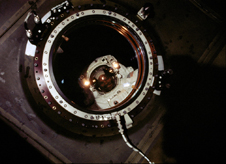
Astronaut Robert L. Curbeam, Jr., STS-98 mission specialist, was photographed during the second of three spacewalks by a member of the Expedition 1 crew in the newly installed Destiny laboratory. Photo Credit: NASA
February 28, 2011 Vol. 4, Issue 2
The “crown jewel” of the International Space Station celebrates its 10th anniversary this month.

Astronaut Robert L. Curbeam, Jr., STS-98 mission specialist, was photographed during the second of three spacewalks by a member of the Expedition 1 crew in the newly installed Destiny laboratory. Photo Credit: NASA
It seems fitting that a module called Destiny would be so expensive and complicated that it could not have a backup. NASA had one shot to get Destiny right. A single malfunction in the transportation and installation laboratory would have pushed back the International Space Station schedule for several years. When engineers discovered the possibility of faulty wire in the shuttle, NASA delayed the mission for three weeks to resolve it.
On February 7, 2001, the Space Shuttle Atlantis carried the 16-ton, $1.4 billion Destiny research module into low-Earth orbit. Described as “the cornerstone for space-based research aboard the orbiting platform,” the Destiny module was vital for advancing the ISS as a permanent and highly functioning international laboratory.
Boeing began building Destiny in 1995 at the Marshall Space Flight Center. The 28 by 14-foot, waffle-patterned, aluminum structure housed 24 closet-sized racks: 13 for microgravity science experiments, and 11 for power, cooling water, temperature and humidity control, and air purification. Destiny also hosts the Window Observational Research Facility (WORF), a precursor to the recently installed Cupola module. The telescope-quality window is 20 inches in diameter, which allowed astronauts to shoot high-quality photographs of Earth for the first time.
The mission was crewed by Commander Kenneth Cockrell and Pilot Mark Polansky. Mission specialists Tom Jones and Robert Curbean conducted three space walks, while Marsha Ivins controlled the shuttle’s robotic arm to successfully integrate Destiny with the Unity module.
Read more about the STS-98 mission.





